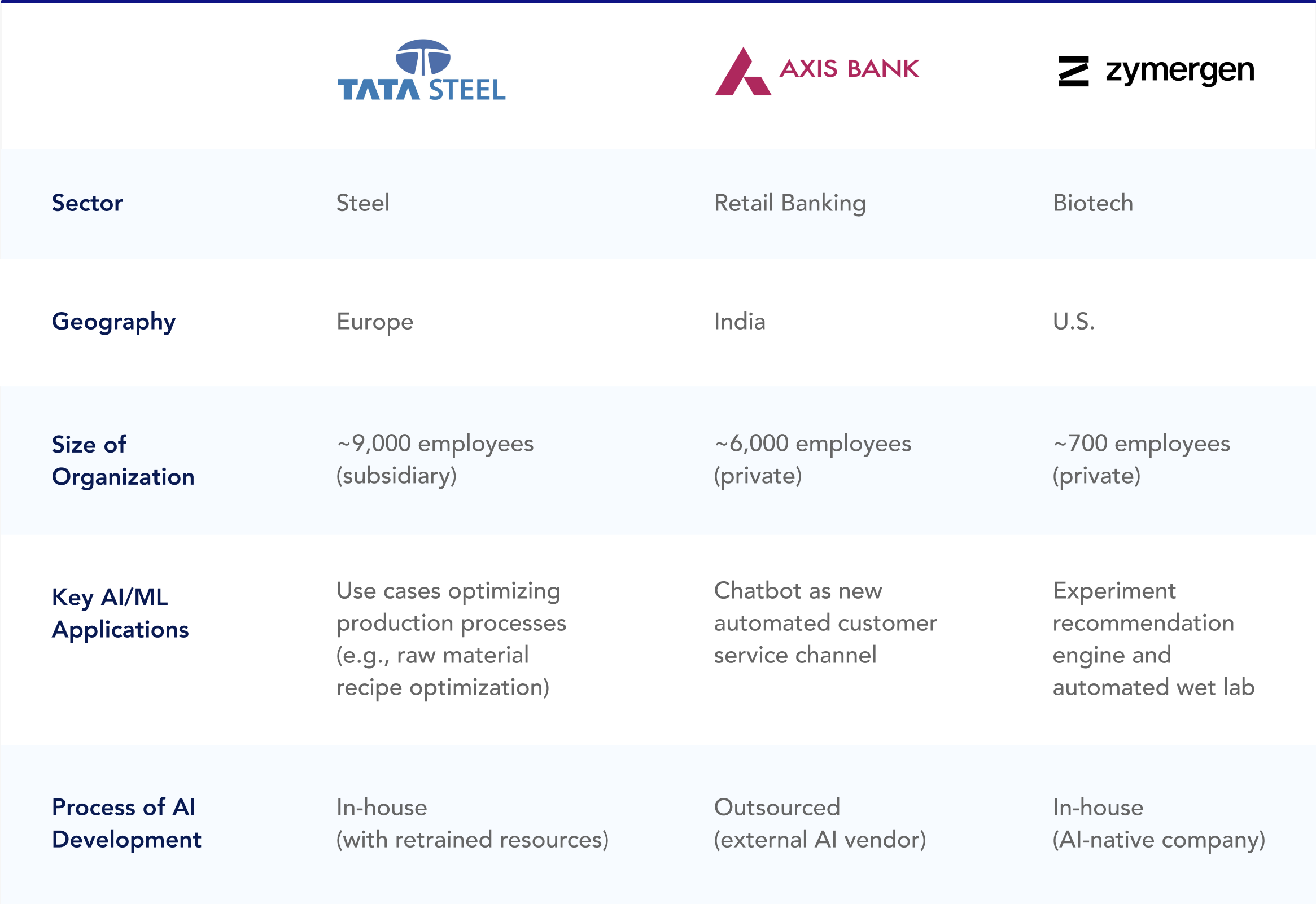CASE STUDIES
Subject Diversity and Common Motifs Subject Diversity and Common Motifs
We present a rich group of stories from three organizations, spanning different industries, geographies, sizes, and use cases of AI and machine learning (ML) techniques. In business circles, many pre-established techniques such as pattern-matching heuristics, or linear regression and other forms of statistical data analysis, have recently been rebranded as “AI” (and in the case of statistical regression, also as “ML”). We accept these expansive definitions not because they are fashionable, but because they are more useful for understanding the economic consequences of present forms of automation. See section “Terms and AI techniques used” for more details on how these terms are defined.) AI, a notoriously broad and nebulous term, refers to the science and engineering of systems that could be described as making machines intelligent, able to function appropriately and with foresight in an environment. Nils J. Nilsson, The Quest for Artificial Intelligence: A History of Ideas and Achievements, (Cambridge, UK: Cambridge University Press, 2010). ML, presently the most successful sub-field of AI, enables computer systems to learn from data to improve performing a task rather than designing a static algorithm to perform a specific task. Of note, each case study varied in the AI/ML techniques used to achieve organizational ends, and organizations often used a combination of approaches (See section “Terms and AI techniques used” for further details.)
The Tata Steel Europe case, based in the Netherlands, describes how an incumbent steel manufacturer, facing significant industry headwinds, launched an internally-developed AI strategy (referred to internally as “Advanced Analytics”) to optimize its production processes with both ML models and workforce retraining to build and integrate them. The company reports significant economic benefits and productivity gains with a lower investment than alternative, higher-cost capital investments. Notably, the company reports avoiding immediate layoffs by retraining many in its workforce to develop and implement the AI models – though this may not always remain the case, nor may it be the equilibrium that emerges across the entire industry.Quoted figures are reported from subject organizations, not independent analyses
The Axis Bank case, based in India, explores how an AI chatbot addressed a growing need to improve customer service in a cost-effective and scalable way through automation. In addition to examining AI’s impact on Axis Bank’s internal workforce, the case discusses how labor impacts cascaded outside the bank and across sectors to third-party customer service providers and technical vendors. As the case illustrates, the social and labor impacts can often cascade beyond the location of the AI implementation. Kate Crawford and Vladan Joler explore this concept extensively as it relates to the “vast planetary network” of labor, energy, and data to support small interactions with an Amazon Echo. See more at www.anatomyof.ai.
The Zymergen case examines how a biotech startup in the San Francisco Bay Area is applying machine learning and automation as an alternative to conventional R&D and scientific experimentation practices. The case includes observations on the productivity impact of AI in that setting, as well as the labor implications for a highly educated workforce (e.g., scientists with Ph.D.’s).
Each of the organizations profiled has different strategic motivations and thus different approaches to developing AI/ML-related applications. Tata Steel Europe is an incumbent trying to build an AI capability in-house through training its existing labor resources. Axis Bank, another incumbent, chose to bring in a third-party AI vendor to help develop its chatbot capability. Finally, Zymergen is an “AI-native” An ‘AI-native’ refers to a company that was founded with a stated mission of leveraging artificial intelligence or machine learning as a key enabling technology. ‘AI-natives’ can build infrastructure from the ground-up without the need to shift from legacy systems (e.g., on-premise to cloud-based storage). startup developing material science R&D services.
Common Motifs
Despite the variety in sector, geography, size and AI applications of the firms we studied (See Figure 1 below) three common motifs emerged:
- Successful adoption of new AI systems required buy-in from management and the workforce alike. In doing so, having intelligible ML models was of paramount importance.
- Each firm reported productivity or ROI growth in the short term, but in all cases, these effects could not be attributed solely to AI, as other process changes always accompanied the introduction of AI technologies.
- There were varying impacts on the local workforce due to the adoption of AI systems and no reported layoffs to date, but the effects were difficult to measure internally and in some cases, cascaded beyond the firms we studied into their third-party vendors and broader business ecosystems.
Figure1. Overview of case study attributes

Source: Case study

